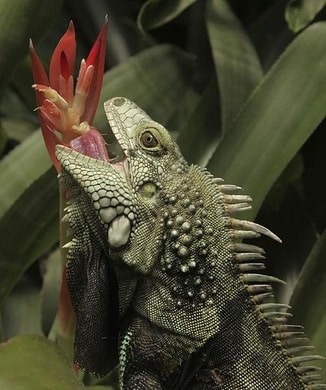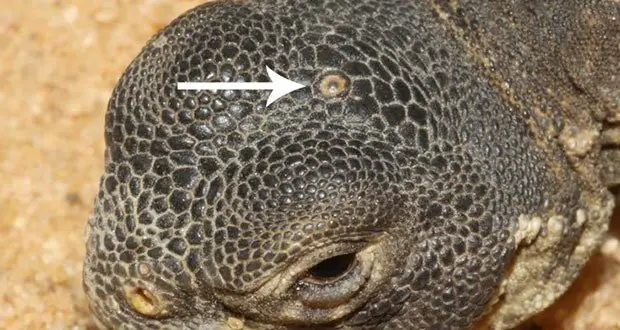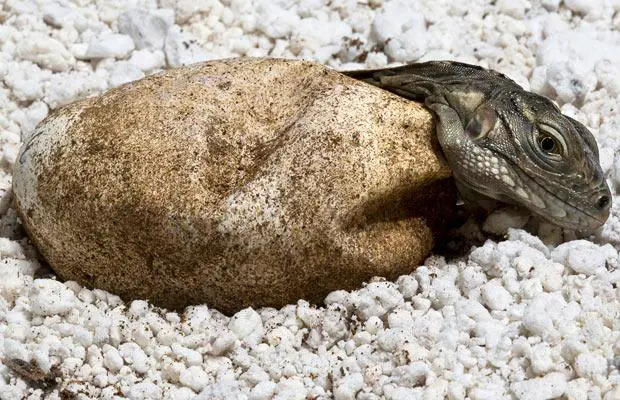The iguana is a beautiful animal. This lizard comes in many colors and they’re all equally gorgeous. However, while most people know a thing or two about these animals there’s always more to learn. In this post I’m going to go over 20 interesting facts about iguanas, ranging from interesting, to cool, to downright weird.
I hope this list is not only entertaining to read but is also educational and that it will teach you something new. Iguanas are magnificent creatures and there’s so much to learn about them.
[no_toc]20 Amazing Iguana Facts
1. Iguanas are herbivorous

When you see an iguana they look quite intimidating. I mean, just look at them, they pretty much look like smaller dragons. Their fierce appearance leads many people to believe that these creatures must be carnivorous. But that’s not the case, iguanas feed on plants and do not eat meat at all. They get all their nutrition from plant-based foods.
2. Salmonella lives on their skin
Salmonella, yeah the same bacteria that can be found on raw chicken, lives on the skin and intestines of this reptile.
Their poops contain the bacteria which then gets spread around their enclosure and onto their skin. Always be careful when handling an iguana and make sure to wash your hands!
3. The blue iguana was almost extinct
The blue iguana is one of the prettiest animals in the world. Their appearance is truly majestic and at one point the world almost lost its beauty entirely. They were on the brink of extinction in the wild. A few years ago, in 2002, there were less than 25 of these animals left. Nowadays, there are more than 750! It is because of the heroic efforts of conservationists that they still exist in the wild.
Check out this video to learn more about the battle these creatures had with extinction and how they were preserved:
4. Iguanas do have teeth
There are some misconceptions about iguanas and their teeth out there. Some people believe that they do not even have them in the first place. This is not true and they do have teeth. The primary reason why people are under the impression that they do not have them is because of how transparent their teeth are.
5. They can grow up to 6 feet in length
6 feet or around 1.8 meters is how large these reptiles can grow if you include their tail in their size. That’s a pretty substantial size for a lizard! They’re among the largest lizards in the world and one of the largest that you can have as a pet.
Males are usually larger than females.
6. Their tail can be used in self-defense

The iguana’s tail is no joke. This huge appendage can be used in a whip-like manner in self-defense. They can exert enormous amounts of pressure by using their tail, enough to even draw blood or break bones in humans.
To learn more, check out this guide covering whether iguanas are dangerous.
7. Many people keep them as pets
Iguanas are popular pets. In the United States, they are among the most popular pet reptiles. However, while they are often kept as pets there are a lot of things you have to take into consideration before getting one as a pet. Things you need to take into account are factors such as their costs and if you have enough space to house them. They’re not beginner pets!’
8. They can grow very old in captivity
In captivity, these animals can live for up to 30 years. That’s pretty much twice as long as your average dog or cat. This is yet another factor that potential iguana owners have to take into account. It happens all too often that people are unprepared, yet choose to adopt an iguana only to realize that they can not take care of it properly.
The record for the oldest iguana is a blue iguana named Godzilla. He died at the old age of 69. 54 of those years were spent in captivity and 15 were spent in the wild.
Unfortunately, according to research, most pet iguanas die within the first few years due to improper care.
9. They are illegal in some places
Owning an iguana as a pet is not legal everywhere. In the United States, it’s not legal to own one of these creatures in places like New York City and Hawaii. The reason why they’re illegal in NYC is that they’re deemed harmful to the public. In Hawaii, it’s because they’re a threat to the local ecosystem.
There are also entire countries where owning an iguana is illegal. If you’re considering getting one always do your research about the legality of owning one.
10. Iguanas can release their tail
I’m sure you’ve heard of some lizards being able to release their tail when they’re being threatened and feel like they can’t escape. Iguanas can do the same, but since their tail is so huge it takes quite a long time for them to grow back.
It can take up to a full year for their tail to grow back completely. If the iguana is younger the tail grows back faster.
11. Their bites can do serious damage
Remember number 4 about their teeth? Even though some people mistakenly believe that these animals do not have teeth, their teeth can do some serious damage when they use them to bite. They have 120 serrated teeth in their mouth that can inflict huge wounds on humans when they’re bitten. These wounds almost always require medical attention so be careful when handling these creatures.
It was long believed that iguanas do not have venom but in 2005 it came to light that they do possess a very weak venom. Luckily this venom is not threatening for humans so it’s not anything to worry about. The bigger worry when you get bitten is their sharp teeth and the bacteria that live in their mouth.
12. They can form bonds with humans
The socialization of an iguana is a very long process that can take years. According to Wikipedia, it will take about 5 to 10 years for them to be fully bonded to a human. At that point, they can display similar tendencies as mammalian pets such as separation anxiety.
13. Iguanas grow very quickly
As babies, these lizards are very tiny and adorable. That doesn’t last long. These tiny animals grow into their majestic fully grown creatures in about 3 years but during these 3 years, they have crazy growth spurts.
Because they grow so fast (and so big) people who impulse-buy these creatures on the assumption that they will stay relatively small are in for a rude awakening.
14. They have a third eye

Believe it or not, iguanas have a third eye. This third eye is not used to look but has a different purpose. It’s called a Parietal eye or pineal eye and is located on the top of the head. This third eye is used for regulating circadian rhythmicity and hormone production for thermoregulation.
Many other lizards, frogs, salamanders, and sharks also have this third eye.
15. Mothers do not take care of their children
Baby iguanas have quite a rough start. Unlike many other animals, the mother iguana does not take care of her young. She simply lays her eggs in a nest, covers them up, and leaves. The babies are then left to fend for themselves. They have to dig to the surface and their struggle for survival begins.
16. Females lay up to 70 eggs

Once per year the female iguana lays her eggs. They lay anywhere between 20-70 eggs. They lay their eggs underground to protect them from predators and the smoldering heat.
In countries in South and Central America humans occasionally eat these eggs and the iguanas that lay them. These animals are native there and there are so many of them that they have been nicknamed gallino de palo which means “chicken of the trees”.
17. Swimming is not a problem for them
Iguanas are amazing swimmers. They can hold their breath for up to 30 minutes at a time! Also, they can swim long distances. There are no scientific studies available on how far they can swim but they’ve been known to swim between islands.
Iguanas from Santa Cruz have been found on San Cristobal which is more than 65 km (40 miles) away!
18. They have a dewlap
Ever wondered what the flap of skin under the chin of the iguana is for? It’s called a dewlap and has several purposes. First, it’s used for intimidation. If the iguana feels threatened they can blow show their dewlap as a means to intimidate any potential attacker. They can also use their dewlap as a means of attracting a female. Finally, this flap of skin can be used to regulate their body temperature.
19. They can freeze
There was a strange phenomenon in Florida this winter: iguanas were falling from trees.
They were falling because the cold temperatures caused them to freeze. The temperatures in Florida in January reached around 4 degrees Celsius and that’s the point at which they freeze. At that point, they become immobile and are no longer able to hold onto the trees they live in. As a result, they fall to the ground.
Luckily for the iguana, they can survive falls from up to 50 feet so falling from trees usually does not kill them. Once the temperatures rise back up they will regain their energy and go on their merry way.
20. They have intricate social structures
Many reptiles are solitary, but not iguanas! They form complex social structures. According to Scientific American, they have an active social life where they protect their siblings, have social nesting, and play with one another.
However, males can become quite territorial, especially during the breeding season.
- How Long Do American Eskimo Dogs Live? Important Factors and Care Tips - September 29, 2023
- Do American Bulldogs Need Grooming? Essential Tips and Care Guidelines - September 29, 2023
- Do Bengal Cats Enjoy Playing? Essential Tips for Keeping Them Active - September 29, 2023